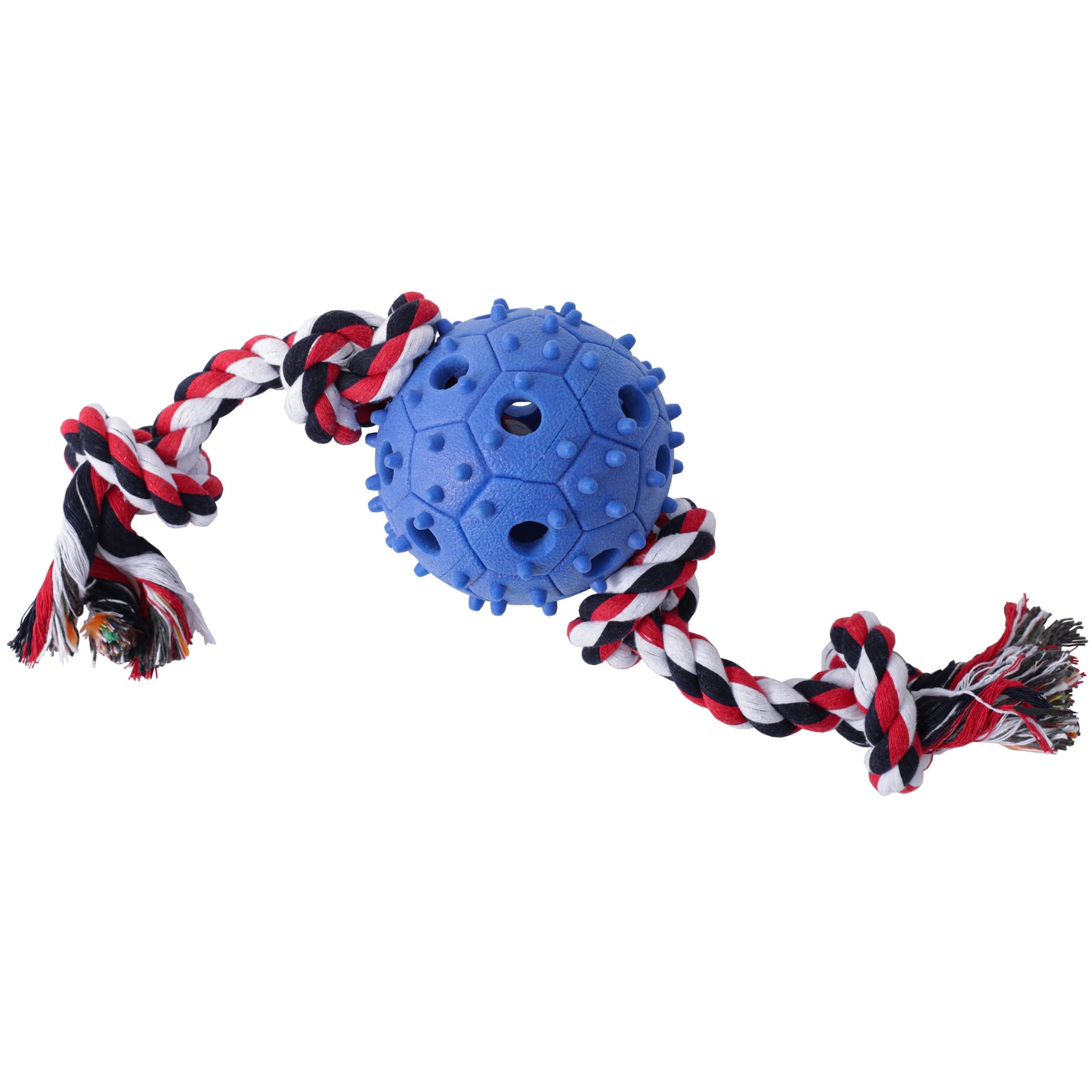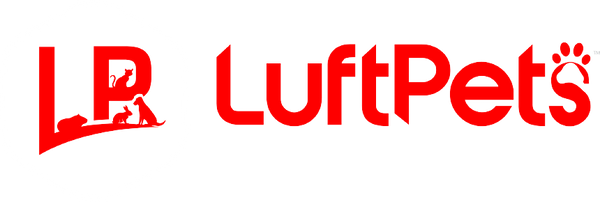Durable Dog Chew Toy with Rope - Interactive Rubber Ball & Knotted Tug Rope for Dogs
Durable Dog Chew Toy with Rope - Interactive Rubber Ball & Knotted Tug Rope for Dogs
Couldn't load pickup availability
This product is a durable and engaging dog toy featuring a textured rubber ball and two knotted rope ends. The design combines the chewable, bouncy qualities of rubber with the satisfying texture of braided rope, making it appealing for a variety of play styles, including chewing, tugging, and fetching. Here’s a detailed description of its features and benefits:
Material and Build
The toy consists of a high-quality, non-toxic rubber ball and a strong, tightly braided rope. The ball is designed with multiple textures and small, raised nubs, providing an interesting feel for dogs as they chew and bite. The rubber is soft enough to be gentle on a dog’s gums and teeth, yet resilient enough to withstand prolonged chewing. Additionally, the rubber ball includes holes, making it easier for the dog to grasp during play.
The rope, composed of interwoven strands in red, black, and white, is designed to be sturdy, resisting fraying and tearing even with intense pulling. The ends are tightly knotted, giving the toy extra strength for tugging sessions and adding durability. This multi-material construction enhances the toy’s lifespan and provides a diverse sensory experience for dogs.
Interactive Play Options
This dog toy is versatile in its use. Owners can use it for:
-
Tug-of-War: The knotted rope ends are ideal for tugging. Tug-of-war is an excellent bonding activity for dogs and their owners, building trust and reinforcing training cues like “drop” and “release.”
-
Fetch: The toy can be thrown, with the ball adding weight and bounce, making it ideal for playing fetch. The shape and material make it easy for dogs to catch and carry.
-
Chew Toy: The textured ball offers dogs an outlet for their natural chewing instincts. Chewing can help keep their teeth clean by reducing plaque buildup, and the textured nubs provide a gentle massage to their gums, promoting dental health.
-
Solo Play: For dogs that enjoy entertaining themselves, the toy can be tossed and chewed independently, making it a good option for keeping them occupied when left alone.
Benefits for Dogs’ Health and Behavior
Playing with this toy provides numerous health and behavioral benefits:
- Dental Health: The nubby texture of the ball helps clean teeth and massage gums, which can help prevent dental issues such as plaque buildup and gum disease.
- Mental Stimulation: Engaging in interactive games like tugging and fetching keeps dogs mentally stimulated, which is crucial for reducing boredom and preventing destructive behavior.
- Exercise: Running, tugging, and chewing on this toy contribute to a dog’s physical exercise, keeping them fit and healthy.
- Relief from Boredom and Anxiety: Having a durable, engaging toy can help alleviate boredom and separation anxiety, reducing tendencies toward destructive behaviors such as chewing on furniture.
Durability and Suitability
The combination of rubber and rope makes this toy highly durable, suitable for dogs with moderate to strong chewing habits. The size of the ball and rope length make it ideal for medium to large dogs, though it may also work for smaller dogs that enjoy playing with larger toys. The toy’s durability helps ensure it will last through extended play sessions without quickly wearing out or breaking apart.
Easy to Clean
The rubber ball can be easily wiped clean or rinsed with water, and the rope can be washed if it becomes dirty. Regular cleaning will help maintain the toy's hygiene, ensuring it remains a safe and enjoyable option for dogs.
Summary of Key Features
- Textured Rubber Ball: Provides an exciting texture for chewing and helps clean teeth and gums.
- Knotted Rope Ends: Ideal for tug-of-war and adds durability to the toy.
- Multi-Use: Suitable for tugging, fetching, chewing, and solo play.
- Health Benefits: Promotes dental health, provides mental stimulation, and encourages physical exercise.
- Durability: Made from tough rubber and durable rope, designed to withstand prolonged use.
- Easy to Clean: The toy can be easily washed, making maintenance simple.
This toy is perfect for pet owners looking for a versatile, durable, and beneficial toy that will engage their dog in various ways. Whether for bonding through tug-of-war, satisfying a dog's chewing instincts, or simply keeping them entertained, this toy is a valuable addition to any pet’s playtime routine.
Share


Frequently Asked Questions
1. What are cage liners for guinea pigs?
Cage liners for guinea pigs are specially designed mats or pads that are placed on the floor of the guinea pig's cage. They serve as a protective barrier, absorbing urine and preventing it from seeping into the cage floor. Cage liners help maintain a cleaner and more hygienic environment for your guinea pigs.
2. Why should I use cage liners for my guinea pig's cage?
Using cage liners offers several benefits. They help to minimize odors by trapping urine and reducing ammonia buildup. They are also more comfortable for your guinea pigs to walk on than bare cage floors. Additionally, cage liners make the cleaning process much easier and save you time and money on bedding materials.
3. Are cage liners reusable?
Yes, most cage liners for guinea pigs are reusable. They are typically made from durable materials that can withstand multiple washes. After removing any solid waste, you can simply toss them in the washing machine and reuse them once they are clean and dry. Reusable cage liners are a cost-effective and eco-friendly option.
4. How often should I change the cage liners?
The frequency of changing cage liners depends on various factors, such as the size of the cage, the number of guinea pigs, and their habits. As a general guideline, it is recommended to change the liners at least once or twice a week. However, if you notice any strong odors or excessive soiling, it's best to change them more frequently.
5. Can I use cage liners with bedding materials?
Yes, you can use cage liners with bedding materials if you prefer. Some guinea pig owners find that using a combination of liners and bedding offers the best of both worlds. The liners provide a protective layer, while the bedding adds extra comfort and nesting material for the guinea pigs. Experiment with different setups to see what works best for you and your pets.
6. How do I clean cage liners?
Cleaning cage liners is simple. First, remove any solid waste from the liner. Then, shake off any loose debris or hay. You can either hand wash the liners with mild soap and warm water or toss them in the washing machine gently. Avoid using harsh chemicals or bleach as they may harm your guinea pigs.
After washing, lay the liner flat and smooth out any wrinkles or folds to straighten the liner. If needed, you can use a cool iron to get rid of persistent creases. Make sure the liners are thoroughly dry before placing them back in the cage.
For a more visual guide on these steps, here are some instructional videos that demonstrate cleaning and straightening the liners effectively.
7. Can cage liners be used in any guinea pig cage?
Cage liners are versatile and can be used in most guinea pig cages, including wire cages, plastic-bottomed cages, and C&C (cubes and coroplast) cages. However, it's important to choose the appropriate size of liners that fit your cage dimensions. Ensure that the liners cover the entire floor area of the cage to provide optimal protection and comfort.
8. Are cage liners safe for guinea pigs?
Yes, cage liners are generally safe for guinea pigs. They are designed to be non-toxic and pet-friendly. However, it's essential to choose high-quality liners that are free from any harmful chemicals or substances. Always check the product description and customer reviews before making a purchase. Additionally, monitor your guinea pigs for any signs of discomfort or allergies when using new cage liners.
9. Can cage liners help with odor control?
Yes, cage liners can help with odor control. They are specifically designed to absorb urine and minimize odors in the guinea pig's living area. However, it's important to maintain good cage hygiene by regularly cleaning the liners and the rest of the cage. Proper ventilation and regular spot


